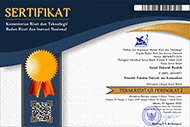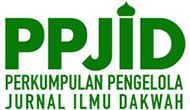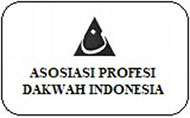Internet and Religious Identity Construction: Jurus Sehat Rasulullah (JSR) Da’i (Preacher) Zaidul Akbar
Abstract
The presence of the internet has influenced the way people interact with their social environment, including in the context of religion. Internet seems to eliminate boundaries, space and time in social interactions. This led to a fundamental change in how a person’s identity was formed. This study discusses how online interactions can shape one’s religious identity. “Jurus Sehat Rasulullah” as a da'wah theme which encourages Muslims to maintain their health and perform Islamic medicine is analyzed textually. This qualitative research in collecting data using online observation by observing JSR and its users. The search was focused on the Instagram account @ZaidulAkbar. The results showed that there was a religious identity construction process through the exchange of symbols among internet users who followed the official account of “Jurus Sehat Rasulullah.”
Keywords
Full Text:
PDFReferences
Abdullah, Irwan. (2017). Di Bawah Bayang-Bayang Media: Kodifikasi, Divergensi, dan Kooptasi Agama di Era Internet. Sabda: Jurnal Kajian Kebudayaan, 12 (2).
Anderson, R. H., & Hearn, A. C. Anderson, B. (1983). Imagined Communities: Reflections on the Origin and Spread of Nationalism, revised edition, London: Verso. Cyber Conflict and Global Politics.
Armfield, G. G., & Holbert, R. L. (2003). The Relationship Between Religiosity and Internet Use. Journal of Media and Religion, 2 (3).
Bockover, M. I. (2003). Confucian Values and The Internet: A Potential Conflict. Journal of Chinese Philosophy, 30 (2).
Campbell, H. A. (Ed.). (2012). Digital Religion: Understanding religious practice in new media worlds. London: Routledge.
Castells, M. (2011). The rise of the network society. Vol. 12. John Wiley & Sons.
Charon, Joel M. (1979). Symbolic Interactionism. United States of America: Prentice Hall Inc.
Cox, H. (2013). The secular city: Secularization and urbanization in theological perspective. Princeton University Press.
Creswell, John W. (2017). Research Design: Pendekatan Kualitatif, Kuantitatif, dan Mixed. Yogyakarta: Pustaka Pelajar.
Hadden, J. K., & Cowan, D. E. (Eds.). (2000). Religion on the Internet: Research prospects and promises. New York: Jai.
Hardy, M., Skirbekk, V., & Stonawski, M. (2020). The religiously unaffiliated in Germany, 1949–2013: Contrasting patterns of social change in East and West. The Sociological Quarterly, 61(2).
Hayati, A. R., dkk. (2020). Fenomena Komunikasi Muslimat Bercadar Melalui Media Sosial di Pekanbaru. Jurnal Risalah Dakwah. Vol. 31, No. 1. DOI: 10.24014/jdr.v31i1.9949
Hojsgaard, M., & Warburg, M. (2005). Introduction: Waves of research. Religion and cyberspace.
Hesapci Sanaktekin, O., Aslanbay, Y., & Gorgulu, V. (2013). The effects of religiosity on Internet consumption: A study on a Muslim country. Information, Communication & Society, 16 (10).
Iskandar, I., & Widyastri, S. (2020). Pesan Dakwah Zaidul Akbar di Youtube Perspektif Meanings and Media. Jurnal Tadbir, Volume 2, Nomor 2, Desember 2020, 228- 254.
Lengauer, D. (2018). Sharing semangat taqwa: social media and digital Islamic socialities in Bandung. Indonesia and the Malay World, 46 (134).
Madung, O. G. (2011). Relasi Agama dan Moralitas Masyarakat Postsekular Negara: Telaah atas Pemikiran Juergen Habermas. Millah: Jurnal Studi Agama, 10 (2).
Martin, D. (1965). Towards Eliminating The Concept Of Secularization. In Penguin Survey of The Social Sciences, (UK): Pengiun Books.
Maulida, H., dkk. (2020). Komunikasi Kesehatan Perilaku Hidup Sehat #JSR di Media Sosial. Jurnal Teras Kesehatan, Vol. 3, No. 1, 18-32.
Prasanti, D. (2020). Internalisasi Nilai Islam di Era Post-truth: Instagram dr@zaidulakbar sebagai Media Literasi Informasi Kesehatan. Jurnal Al-Izzah, Vol 15, No. 1.
Prawira, Y. R., & Maulida, H. (2020). Kredibilitas Komunikator Jurus Sehat Rasulullah di Kalangan Followers Instagram @Zaidulakbar. Jurnal Dakwah Risalah, Vol. 31, No. 1. DOI: 10.24014/jdr.v31i1.9527
Schroeder, R., Heather, N., & Lee, R. M. (1998). The sacred and the virtual: Religion in multi-user virtual reality. Journal of Computer-Mediated Communication, 4 (2).
Stark, Rodney. (1999). Secularization, RIP. Sociology of religion, 60 (3).
Van Bruinessen, M. (Ed.). (2013). Contemporary Developments in Indonesian Islam: Explaining the conservative Turn. Institute of Southeast Asian Studies.
https://tekno.kompas.com/read/2019/05/16/03260037/apjii-jumlah-pengguna-internet-di-indonesia-tembus-171-juta-jiwa (Diakses pada 21/10/2021, 03:26 WIB)
https://www.liputan6.com/tekno/read/3998624/jumlah-pengguna-instagram-dan-facebook-indonesia-terbesar-ke-4-di-dunia (Diakses pada 21/10/2021, 14:13 WIB)
DOI: http://dx.doi.org/10.24014/jdr.v32i2.15711
Refbacks
- There are currently no refbacks.

This work is licensed under a Creative Commons Attribution-ShareAlike 4.0 International License.
Editorial Office:
2nd Floor, Building of Faculty of Da'wah and Communication, Universitas Islam Negeri Sultan Syarif Kasim Riau. Jl. HR Soebrantas Km 15, Simpangbaru, Tampan, Pekanbaru
Email : jurnalrisalah@uin-suska.ac.id



















